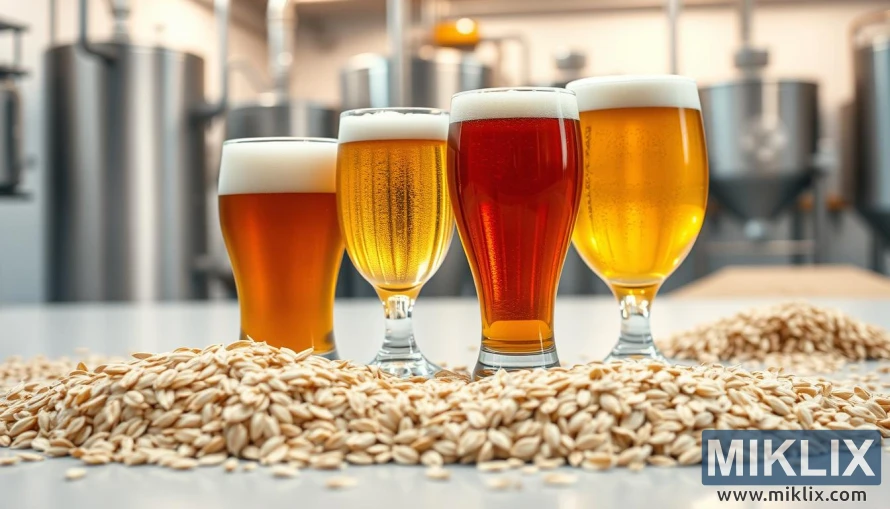Image: Oat Varieties Impacting Beer Flavor
Published: July 23, 2025 at 6:23:42 AM UTC
Last updated: September 27, 2025 at 5:24:40 PM UTC
Different oat types showcased with beer glasses, highlighting their effects on aroma, flavor, and brewing quality.
In this richly composed image, the viewer is drawn into a visual narrative that bridges the agricultural origins of oats with their transformative role in modern brewing. The foreground is a study in texture and subtle variation, showcasing an array of oat varieties—rolled oats, steel-cut oats, whole oat groats—each meticulously arranged on a clean, minimalist surface. The lighting is soft and warm, casting gentle highlights across the grains and revealing their nuanced tones, from pale ivory to golden tan. The setting is pristine and uncluttered, allowing the oats to take center stage and inviting close inspection of their shapes, surfaces, and densities. This clarity of presentation evokes a sense of reverence for the ingredient, elevating it from humble grain to essential brewing adjunct.
Just beyond the oats, the middle ground introduces a vibrant contrast: a row of beer glasses, each filled with a distinct style that reflects the influence of the oat variety used in its creation. The beers range in color from straw-pale to deep amber and hazy gold, their foam crowns fresh and inviting. The clarity or opacity of each beer hints at its body and mouthfeel—some are crisp and bright, others dense and velvety. The visual diversity of the beers mirrors the functional versatility of oats in brewing. Rolled oats contribute a creamy texture and smooth finish, ideal for stouts and hazy IPAs. Steel-cut oats offer a more rustic mouthfeel and subtle graininess, perfect for farmhouse ales. Whole oat groats, less commonly used, impart a gentle sweetness and earthy undertone that can round out more experimental styles.
The glasses themselves are varied—tulip, pint, snifter—chosen to complement the beer styles and enhance their aromatic profiles. The lighting continues to play a key role here, catching the glint of carbonation and the subtle gradients of color within each glass. The arrangement is deliberate yet natural, suggesting a tasting session or a brewer’s comparative study. The beers are not just beverages—they are expressions of process, ingredient, and intention.
In the background, the image fades into a soft blur, revealing the contours of a modern brewery or laboratory. Stainless steel tanks, control panels, and shelving units are visible but indistinct, their forms softened to maintain focus on the foreground. This backdrop adds depth and context, grounding the scene in a space of experimentation and precision. It suggests that the beers and oats in the foreground are part of a larger inquiry—a study in flavor, texture, and brewing technique. The presence of scientific equipment and industrial infrastructure reinforces the idea that brewing is both an art and a science, where tradition meets innovation in pursuit of excellence.
The overall composition is balanced and immersive, guiding the viewer’s eye from grain to glass to the broader setting in a seamless flow. It communicates not just the aesthetic appeal of oats and beer, but their interconnectedness—the way a single grain can shape the experience of a pint, the way brewing decisions ripple through every stage of production. The image celebrates the quiet complexity of brewing, the sensory richness of oats, and the thoughtful craftsmanship that turns raw ingredients into refined beverages. It’s a portrait of process, a meditation on material, and a tribute to the subtle power of adjuncts in the brewer’s toolkit.
The image is related to: Using Oats as an Adjunct in Beer Brewing

